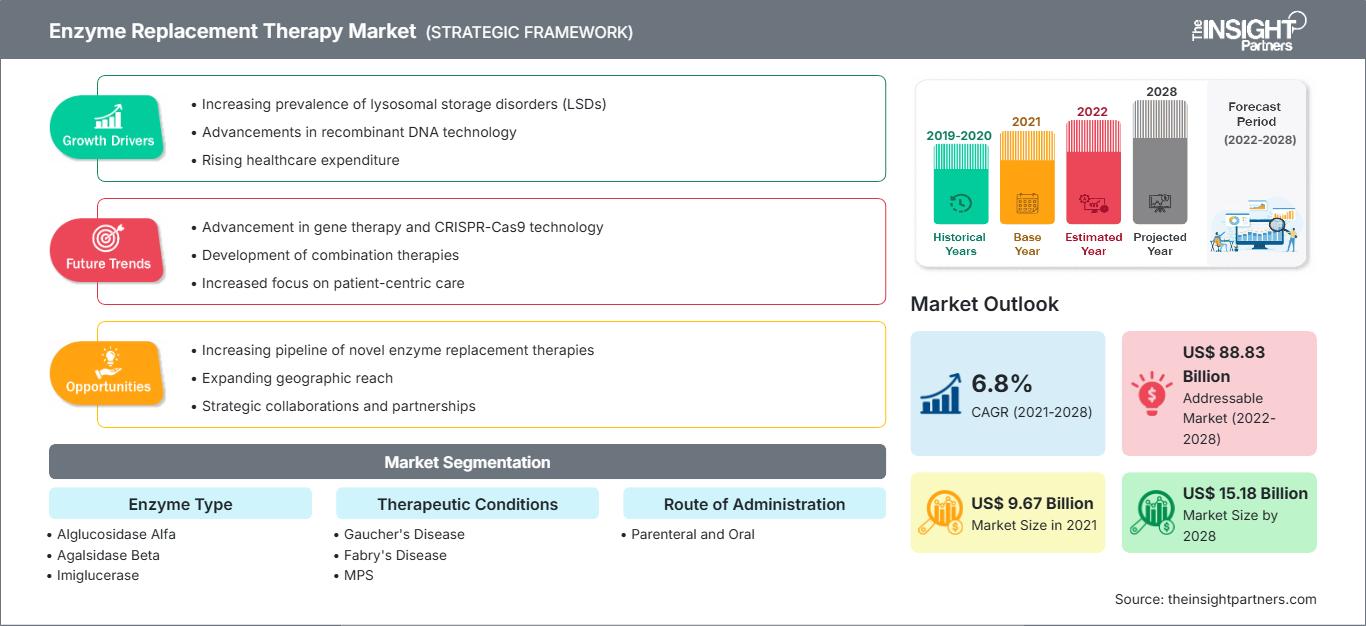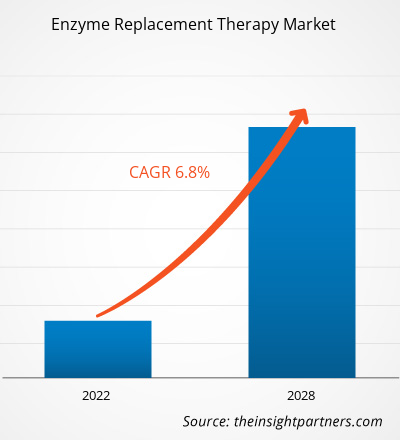Se espera que el mercado de terapia de reemplazo enzimático crezca de US$ 9.673,39 millones en 2021 a US$ 15.184,70 millones en 2028; se estima que crecerá a una CAGR del 6,8% entre 2022 y 2028.
La terapia de reemplazo enzimático (TRE) se realiza para tratar deficiencias enzimáticas congénitas mediante el uso de enzimas o proteínas con actividad enzimática. Las enzimas animales, humanas y de ingeniería recombinante son algunas de las fuentes de enzimas necesarias para el tratamiento. La terapia se aplica generalmente en enfermedades raras y de depósito lisosomal, como la enfermedad de Pompe, la enfermedad de Fabry, la enfermedad de Gaucher, la enfermedad de Tay-Sachs y el síndrome de Hurler. El método de TRE más común son las infusiones intravenosas, en las que la enzima de reemplazo se administra directamente en el torrente sanguíneo mediante un goteo controlado de líquidos. El crecimiento del mercado mundial de la terapia de reemplazo enzimático se atribuye a la creciente prevalencia de las enfermedades de depósito lisosomal (EDL) ya la rápida aprobación regulatoria, junto con otras ventajas comerciales para los medicamentos con designación de medicamento huérfano. Sin embargo, la feroz competencia entre los actores del mercado obstaculiza su crecimiento.
El informe ofrece información y un análisis profundo del mercado global de terapia de reemplazo enzimático, haciendo hincapié en diversos parámetros, como las tendencias del mercado, los avances tecnológicos, la dinámica del mercado y el análisis del panorama competitivo de los principales actores del mercado global. También incluye el impacto de la pandemia de COVID-19 en el mercado en todas las regiones. Debido a la pandemia de COVID-19, muchas autoridades sanitarias se centraron en la atención relacionada con la pandemia. Además, muchos pacientes que requerían terapia de reemplazo enzimático no recibieron sus infusiones en marzo de 2020 debido a la insuficiencia de los servicios hospitalarios para abordar la carga de pacientes con COVID-19. Los pacientes que requerían TRE afirmaron sentir ansiedad durante los ingresos hospitalarios o con respecto al suministro de medicamentos. Además, los estudios revelaron que algunos pacientes presentaban depresión y un mayor nivel de ansiedad. Por lo tanto, las sesiones programadas de terapia de reemplazo enzimático (TRE) se interrumpieron durante la pandemia de COVID-19, lo que produjo un impacto negativo en el mercado.
Personalice este informe según sus necesidades
Obtendrá personalización en cualquier informe, sin cargo, incluidas partes de este informe o análisis a nivel de país, paquete de datos de Excel, así como también grandes ofertas y descuentos para empresas emergentes y universidades.
Mercado de terapia de reemplazo enzimático: perspectivas estratégicas

-
Obtenga las principales tendencias clave del mercado de este informe.Esta muestra GRATUITA incluirá análisis de datos, desde tendencias del mercado hasta estimaciones y pronósticos.
Perspectivas basadas en la geografía
Por geografía, el mercado global de terapia de reemplazo enzimático está segmentado en América del Norte (EE. UU., Canadá y México), Europa (Francia, Alemania, Reino Unido, España, Italia y el resto de Europa), Asia Pacífico (China, India, Japón, Australia, Corea del Sur y el resto de APAC), Medio Oriente y África (Arabia Saudita, Emiratos Árabes Unidos, Sudáfrica y el resto de MEA) y América del Sur y Central (Brasil, Argentina y el resto de América del Sur y Central).
Perspectivas del mercado
Aumento de la prevalencia de enfermedades de almacenamiento lisosomal (EDL)
Un lisosoma es un orgánulo celular rodeado de membrana que contiene enzimas digestivas. Es el centro celular clave para el catabolismo, el reciclaje y la señalización de macromoléculas. Cualquier defecto en estas funciones provoca la acumulación o el almacenamiento de macromoléculas en los lisosomas, lo que resulta en daño celular. La principal causa de las enfermedades de almacenamiento lisosomal (EDL) son las mutaciones en los genes responsables de la codificación de una enzima lisosomal. Además, las EDL se caracterizan por un error innato del metabolismo que resulta en la ausencia o deficiencia de una enzima. Los bebés y los niños sufren con mayor gravedad que los adultos, ya que pueden heredar el gen defectuoso de uno o ambos padres. Sin embargo, desde la última década, este patrón ha ido cambiando y las EDL son más comunes en adultos.
Además, las distrofias lisosomales de almacenamiento (DSL) abarcan aproximadamente 70 enfermedades, entre ellas la enfermedad de Gaucher, la enfermedad de Niemann-Pick, la enfermedad de Fabry, la enfermedad de Tay-Sachs, las mucopolisacaridosis (MPS) y la enfermedad de Pompe. Estos trastornos son poco frecuentes individualmente, pero en conjunto tienen una prevalencia significativa y afectan a 1 de cada 5000 nacidos vivos. Muchos países realizaron encuestas para comprender el patrón de prevalencia, y la prevalencia general estaba aumentando. Por ejemplo, un estudio publicado en The Lancet Regional Health titulado "Prevalencia de los trastornos de almacenamiento lisosomal en Australia de 2009 a 2020" reveló los siguientes resultados:
- La prevalencia en la población australiana es 1,6 veces mayor (1 por cada 4.800 nacidos vivos) que la prevalencia notificada en 1996 (1 por cada 7.700 nacidos vivos).
- La enfermedad de Fabry fue la más prevalente y representó el 34% de todos los diagnósticos (hasta 2020).
- Los LSD son más comunes en la edad adulta que en la infancia.
Por lo tanto, la creciente prevalencia de LSD y las terapias limitadas para curar la enfermedad están impulsando el crecimiento del mercado mundial de terapia de reemplazo enzimático.
Perspectivas basadas en el tipo de enzima
Según el tipo de enzima, el mercado global de terapia de reemplazo enzimático se segmenta en alglucosidasa alfa, agalsidasa beta, imiglucerasa, idursulfasa, galsulfasa, velaglucerasa alfa y otras enzimas. En 2021, el segmento de otras enzimas representó la mayor cuota de mercado. Se espera que este mismo segmento registre la mayor tasa de crecimiento anual compuesta (TCAC) del mercado entre 2022 y 2028.
Perspectivas basadas en condiciones terapéuticas
Según las condiciones terapéuticas, el mercado global de terapia de reemplazo enzimático se segmenta en enfermedad de Gaucher, enfermedad de Fabry, enfermedad de Pompe, IDCG, MPS y otras afecciones terapéuticas. El segmento de la enfermedad de Gaucher tuvo la mayor participación de mercado en 2021 y se espera que registre la mayor tasa de crecimiento anual compuesta (TCAC) durante el período de pronósticos.
Información basada en la ruta de administración
Según la vía de administración, el mercado global de terapia de reemplazo enzimático se divide en parenteral y oral. El segmento parenteral tuvo una mayor participación de mercado en 2021 y se prevé que registre una mayor tasa de crecimiento anual compuesta (TCAC) durante el período de pronósticos.
Perspectivas regionales del mercado de la terapia de reemplazo enzimático
Los analistas de The Insight Partners han explicado detalladamente las tendencias regionales y los factores que influyen en el mercado de la terapia de reemplazo enzimático durante el período de pronósticos. Esta sección también analiza los segmentos y la geografía del mercado de la terapia de reemplazo enzimático en América del Norte, Europa, Asia Pacífico, Oriente Medio y África, y América del Sur y Central.
Alcance del informe de mercado de terapia de reemplazo enzimático
| Atributo del informe | Detalles |
|---|---|
| Tamaño del mercado en 2021 | US$ 9,67 mil millones |
| Tamaño del mercado en 2028 | US$ 15,18 mil millones |
| Tasa de crecimiento anual compuesta (TCAC) global (2021-2028) | 6,8% |
| Datos históricos | 2019-2020 |
| Período de pronóstico | 2022-2028 |
| Segmentos cubiertos |
Por tipo de enzima
|
| Regiones y países cubiertos |
América del Norte
|
| Líderes del mercado y perfiles de empresas clave |
|
Densidad de actores del mercado de terapia de reemplazo enzimático: comprensión de su impacto en la dinámica empresarial
El mercado de la terapia de reemplazo enzimático está creciendo rápidamente, impulsado por la creciente demanda del usuario final debido a factores como la evolución de las preferencias de los consumidores, los avances tecnológicos y un mayor conocimiento de los beneficios del producto. A medida que aumenta la demanda, las empresas amplían su oferta, innovan para satisfacer las necesidades de los consumidores y aprovechan las tendencias emergentes, lo que impulsa aún más el crecimiento del mercado.

- Obtenga una descripción general de los principales actores clave del mercado de terapia de reemplazo enzimático
Información basada en el usuario final
Según el usuario final, el mercado global de terapia de reemplazo enzimático se segmenta en hospitales, centros de infusión y otros. El segmento de hospitales tuvo la mayor participación de mercado en 2021. Sin embargo, se espera que el segmento de centros de infusión registre la mayor tasa de crecimiento anual compuesta (TCAC) durante el período de pronósticos.
Los actores del mercado global de terapias de reemplazo enzimático adoptan estrategias orgánicas, que incluyen el lanzamiento y la expansión de productos, para expandir su presencia y cartera de productos a nivel mundial y satisfacer la creciente demanda. Algunos de los principales actores que contribuyen al mercado son Takeda Pharmaceutical Company Limited; Sanofi SA; AbbVie Inc.; BioMarin Pharmaceutical Inc.; Terapéutica Amicus; Alexion Pharmaceuticals, Inc. (AstraZeneca); Janssen Pharmaceuticals (Johnson & Johnson Services, Inc.); Recordati SpA; Pfizer Inc.; y CHIESI Farmaceutici SpA.
- Análisis histórico (2 años), año base, pronóstico (7 años) con CAGR
- Análisis PEST y FODA
- Tamaño del mercado, valor/volumen: global, regional y nacional
- Industria y panorama competitivo
- Conjunto de datos de Excel
Informes recientes
Testimonios
Razón para comprar
- Toma de decisiones informada
- Comprensión de la dinámica del mercado
- Análisis competitivo
- Información sobre clientes
- Pronósticos del mercado
- Mitigación de riesgos
- Planificación estratégica
- Justificación de la inversión
- Identificación de mercados emergentes
- Mejora de las estrategias de marketing
- Impulso de la eficiencia operativa
- Alineación con las tendencias regulatorias






















 Obtenga una muestra gratuita para - Mercado de terapia de reemplazo enzimático
Obtenga una muestra gratuita para - Mercado de terapia de reemplazo enzimático